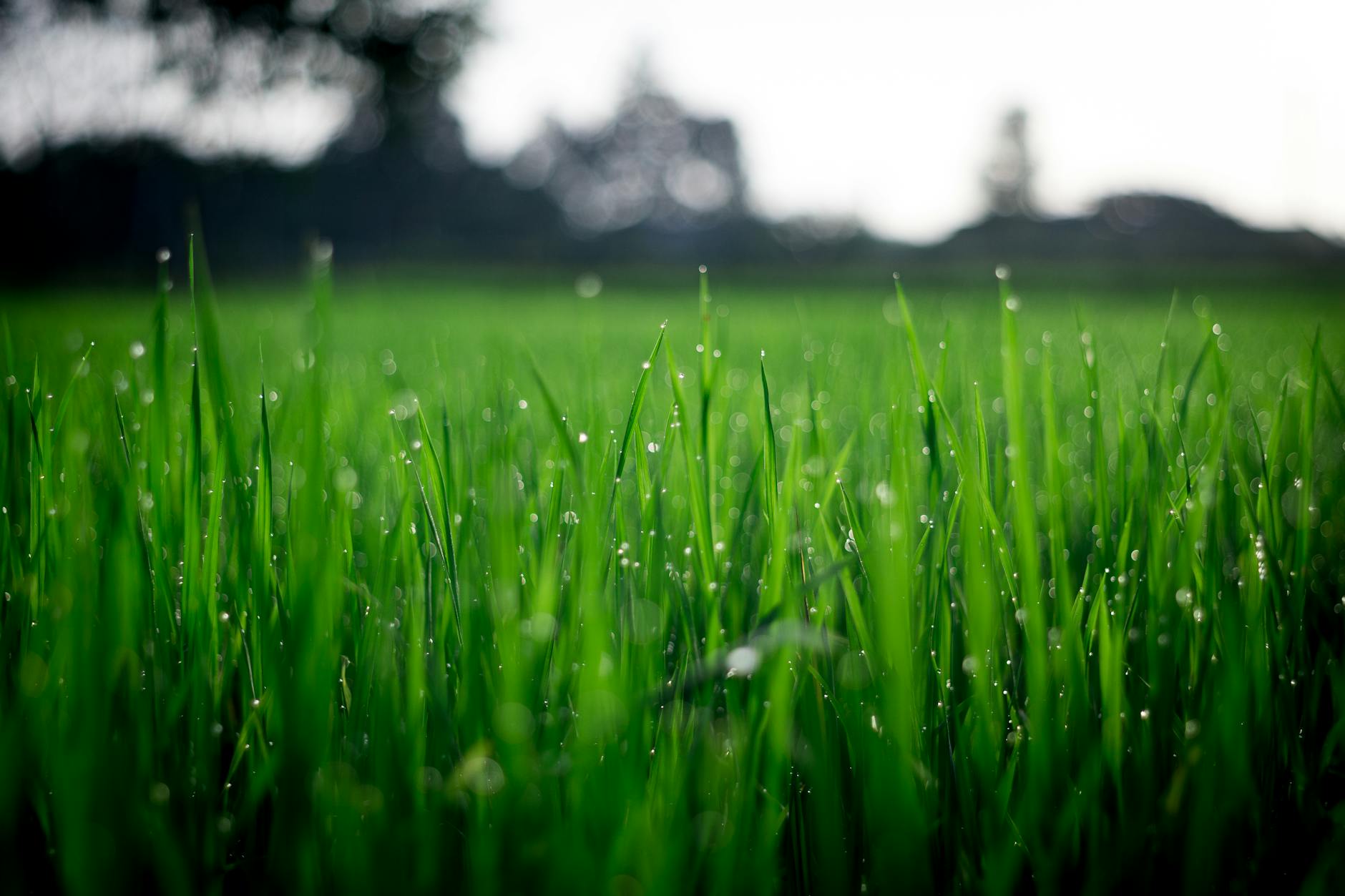Practical Tips for a Greener Lawn
Key takeaways from this article:
- Compost feeds grass naturally by adding nutrients and improving soil.
- Healthy soil holds water better and helps grass look lush.
- You can use traditional compost piles, vermicomposting, or a compost tumbler right at home.
- Applying compost is easy and can be done by top-dressing, mixing, or making compost tea.
- Composting supports a more sustainable lifestyle and reduces waste.
- Anyone can start composting—tools and tips make it simple, even for beginners.
- Useful resources include Composting Grass Clippings Cleanly and Green vs Brown Composting Explained. If you’ve ever wondered, “does compost help grass grow?” the answer is yes—compost can boost your lawn’s health in a natural way. Composting means recycling food scraps, yard waste, and even some paper to make a rich soil conditioner. This process returns nutrients to the ground, helping grass grow greener, thicker, and more resilient.
Composting at home is easier than most people think, especially with tools like a compost tumbler or by trying vermicomposting, which uses worms to break down kitchen waste.
Healthy soil holds water longer and keeps grass looking its best, so composting is a win for anyone hoping for a vibrant lawn and a lighter touch on the planet.
Whether you’re new to composting or already making your own, this guide will show practical tips for using compost, compost tumblers, and even worms to support a thriving backyard.
It’s all about making composting manageable and fun, so your grass—and the whole family—can enjoy the results.
For more tips on recycling everyday items, check out Don’t Toss It: Compost Instead.
How Compost Supports Grass Growth
Adding compost is one of the simplest ways to answer the big question: does compost help grass grow?
Absolutely! Composting at home turns kitchen scraps and yard clippings into a natural lawn superfood.
This keeps grass lush while shrinking your household waste. Each method of composting offers easy wins for your lawn and the environment.
Let’s break down how composting works, how it makes grass thrive, and the best ways to add compost to your lawn.
What Exactly Is Composting?
Composting is nature’s way of recycling. Leftover fruit peels, eggshells, veggie trimmings, or grass cuttings don’t have to go to a landfill—they can become food for your soil.
You might hear about a few different types:
- Traditional compost piles use layers of organic material that break down over a few months with a little turning.
- Vermicomposting uses worms (usually red wigglers) to eat through kitchen scraps, making rich, dark compost full of nutrients.
- Compost tumblers are sealed barrels you can spin easily, helping compost mature faster, with less mess.
Composting keeps useful stuff out of the rubbish and returns it to the earth right where it belongs!
It also helps cut down on greenhouse gases by keeping food scraps out of landfills. If you want a deeper dive into the environmental perks, check out Composting 101 and see just how much good a little pile of scraps can do.
How Compost Improves Soil and Grass Health
Healthy grass starts with healthy soil. When you add compost to your lawn, you feed the earth with slow-release nutrients like nitrogen, phosphorus, and potassium.
These nutrients help grass grow deep roots, which means it can soak up water and stay greener for longer—especially in summer.
But compost does a lot more than feed the grass.
- Improved soil texture: Compost helps sandy soils hold on to moisture and makes heavy clay soils lighter and easier for roots to grow through.
- Supercharged lawns: Microbes in compost break down organic matter, releasing nutrients and building tiny highways for water and air in your soil.
- Resilience: Lawns given compost bounce back faster from foot traffic, drought, or a curious pet.
It’s not just about nutrients—it’s about creating a healthy underground system that keeps your grass looking its best.
Want to know more about the science behind it?
Take a look at the Plant Growth Benefits for more insight on why compost is grass’s best friend.
 Photo by FOX ^.ᆽ.^= ∫
Photo by FOX ^.ᆽ.^= ∫
Ways to Apply Compost to Your Lawn
There are several simple ways to put compost to work for your grass.
No fancy tools are required—just some compost and a little time.
- Top-dressing: Spread compost across the lawn in a thin layer (about ½ inch thick) in spring or autumn. Rake it in gently so it settles down to the roots.
- Aeration and composting: After aerating your lawn (making small holes in the soil), sprinkle compost over the area so it drops into the holes. This is great for lawns that are hard and compact.
- Compost tea: Steep your compost in water for a few days, stir, then pour the liquid over your grass for a speedy nutrient boost.
If you’re not a fan of big, messy piles, a compost tumbler is a tidy way to make compost right in your garden—even in a small space.
Tumblers mix everything up and keep critters out. Interested in learning more about all the different methods?
Visit 6 Effective Composting Methods to find the style that matches your needs and space.
Adding compost isn’t complicated.
With time, the benefits build up. Each method feeds your grass and helps the planet at the same time.
Composting at Home: Easy Steps for a Greener Lawn
Starting your own compost pile or bin is one of the smartest ways to help your lawn. Tossing leftovers and yard debris into compost transforms it into natural food for grass.
The right composting methods and materials can make a huge difference and keep things simple.
Let’s look at which method fits household routines, what you can safely compost, and some easy tricks to keep the whole process fun.
Choosing the Right Composting Method
 Photo by SHVETS production
Photo by SHVETS production
Finding your “compost style” is all about what works best for you—and your grass. Some options take up less space, while others excel at handling lots of lawn clippings.
Here’s a look at the most popular choices:
- Open Pile: Great for big yards and people who don’t mind a visible pile. Just heap your green and brown waste in a corner and turn it with a fork now and then. This is the old-school method and gives you plenty of compost for large lawns.
- Compost Bin: A bin keeps things neat and discourages animals from poking around. For smaller yards or patios, bins are tidy, contained, and can handle leaves, food scraps, and regular grass clippings.
- Compost Tumbler: If you want fast results with less effort, a compost tumbler is a winner. You spin it a few times a week to mix materials, which speeds up decomposition and keeps animals out. Tumblers work well if you want to make compost to topdress your lawn with less mess.
- Vermicomposting: This is composting with worms (usually red wigglers) in a small bin. It’s ideal for apartments or households that don’t have much yard space but still want a steady supply of rich compost—great for garden beds, potted plants, or even a lawn patch.
Each method gets you closer to a greener, healthier lawn.
If you crave more info on each option, check out the 6 Effective Composting Methods guide for a quick snapshot of what fits your needs.
What Can and Can’t Go in Your Compost
Wondering if last night’s veggie peels or this morning’s coffee grounds can join the pile? Compost feeds best on variety—but some things don’t belong.
Here’s a handy guide based on what most people already have at home:
Green (Nitrogen-Rich) Materials:
- Fruit and vegetable scraps
- Coffee grounds and filters
- Fresh grass clippings
- Tea bags (without plastic)
- Plant trimmings
Brown (Carbon-Rich) Materials:
- Dried leaves
- Shredded newspaper or plain paper
- Cardboard (without a glossy finish)
- Straw or hay
- Small twigs
Avoid These in Your Compost for Lawn Use:
- Meat, dairy, or oily foods (attract pests)
- Weeds with seeds or invasive roots
- Pet waste (can carry disease)
- Plastic, metal, or glass
- Glossy, colored, or treated paper
It’s simple: If it’s organic and untouched by chemicals, it probably belongs. Worried about tossing the wrong thing in?
The Don’t Toss It Compost Guide is full of tips for handling household waste safely, making composting even easier.
Quick Tips to Keep Composting Simple
It’s easy to feel lost with compost at first, but a few practical hacks keep frustration at bay. Here are some ways to keep your compost ticking along:
- Chop materials small for faster breakdown, especially if you use a compost tumbler or worm bin.
- Layer greens and browns to balance moisture and prevent a soggy, smelly pile.
- Keep it moist, not soaked. The texture should feel like a wrung-out sponge.
- Turn or spin your pile every week if possible (or let a compost tumbler make it easy).
- Keep an eye out for odors—if it smells bad, add more browns and turn it.
- Watch the weather: Cover piles during heavy rain to avoid soggy compost.
- Start small: Use a tidy bin or tumbler to see how composting fits your routine before growing bigger.
Stay positive—composting takes a little practice, but the results are worth it.
If you want a month-by-month guide, the Composting Calendar Tips guide breaks down what to do each season. Sticking with composting means healthier grass and a lighter eco-footprint.
For even more hands-on tips, check out Composting At Home | US EPA for a helpful reference on home composting, including vermicomposting and other popular methods.
Key Takeaways: Compost and Your Lawn
Wondering if compost is the secret sauce for a greener, thicker lawn? You’re not alone! Many lawn lovers ask, “does compost help grass grow?”
The short answer is yes—compost gives your grass the nourishment it craves and transforms your yard into a lush, healthy retreat.
This section highlights the most important takeaways so you can get the most from your composting efforts, whether you use a classic pile, a compost tumbler, or even prefer vermicomposting.
Quick Answers: Does Compost Help Grass Grow?
- Compost feeds grass with slow-release nutrients. This means your lawn gets a steady supply of what it needs to grow strong—without chemical fertilizers.
- Improves soil texture and health. Compost acts like a sponge, helping soil hold onto moisture and nutrients.
- Supports root development. Deeper roots make grass more drought-tolerant and less likely to brown in summer.
- Natural pest and disease resistance. Lawns built on compost-rich soil bounce back faster from stress, pests, and weather swings.
 Photo by Alfo Medeiros
Photo by Alfo Medeiros
Why Compost Matters for Your Lawn
Compost is more than just garden gold—it’s a life raft for tired grass. Applying compost gives your soil a boost in the following ways:
- Balances nutrients naturally. Unlike synthetic options, compost doesn’t overload the soil. Think of it like a slow-release vitamin for your lawn.
- Encourages beneficial microbes. Microorganisms in compost work their magic, breaking down old plant matter and making food available for grass roots.
- Reduces runoff and erosion. Healthier soil means less water waste and more nutrients sticking around where grass can use them.
In fact, using compost as a topdressing has been shown to improve lawn density and color. Want more on the science?
Check out this guide on topdressing a lawn with compost for in-depth tips and reasons why it’s a smart move.
How Compost Fits Into Everyday Lawn Care
Composting isn’t just for expert gardeners or those with huge backyards. Today, there are plenty of ways to feed your lawn using whatever space or tools you have.
- Traditional piles and bins let you compost yard waste and kitchen scraps in a backyard corner.
- Compost tumblers speed things up and keep the process tidy—great for neat freaks or smaller spaces. Explore Compost Tumbler Options to find which is right for you.
- Vermicomposting uses worms to break down food scraps quickly, making it perfect for apartments or tight spots.
No matter which method you pick, compost will help grass grow better and make your lawn more enjoyable.
If you’re new and want some help getting started, take a peek at the Guide to Starting Composting.
Mistakes are normal—composting is a journey, not a race!
Key Takeaways for Homeowners
Let’s break it down into clear, scannable points:
- Yes, compost helps grass grow. It’s one of the easiest changes you can make for a healthier, greener lawn.
- Compost improves your lawn’s resilience to drought, pests, and heavy foot traffic.
- Compost works with any style: traditional pile, compost tumbler, or vermicomposting—all have benefits.
- Topdressing with compost once or twice a year can benefit almost every lawn.
- Beginner-friendly. Composting fits every budget, skill level, and garden size.
Have kitchen scraps or yard waste? Compost turns them into fuel for your grass, boosting growth while cutting down on rubbish.
To see real-world tips from other composters, take a look at popular forums like this discussion on using compost to improve lawns.
Want to Dive Deeper?
Ready to make compost work for your lawn? Or wondering how to start small with everyday scraps?
For a step-by-step beginner’s guide, browse the Guide to Starting Composting.
If you’re curious about turning scraps into garden gold, the Making Compost from Kitchen Waste guide is packed with tips.
Even one small compost pile, a worm bin under the sink, or a spinning compost tumbler out back can give you greener grass, less landfill waste, and plenty of eco-friendly pride.
Enjoy the process and don’t forget—every bit of compost helps your lawn shine!
Frequently Asked Questions About Composting and Grass Growth
Wondering if compost is the missing piece for thick, green grass?
You’re not alone! Many folks want answers about how composting, vermicomposting, or even a compost tumbler can help boost their lawn.
Let’s clear up the most common questions and share a few tips so your grass looks better than ever.
Does Compost Help Grass Grow?
Yes, compost does help grass grow! Compost is packed with slow-release nutrients that your lawn needs to stay healthy and lush.
When you add compost, you’re giving grass a steady, balanced meal—no chemical fertilizers needed. Compost breaks down over time, feeding the soil and helping grass roots dig deeper for water, especially in dry spells.
For more, check out Composting 101, which explains how this natural process works to enrich your soil.
How Often Should I Add Compost to My Lawn?
Topdress your lawn with compost once or twice a year for best results. Spring and autumn are ideal—these are the seasons when grass is growing most actively.
Just spread a thin layer (about half an inch) right on top and rake it in.
If you are using a compost tumbler, the process is the same, but you might finish your compost more quickly.
Can I Use Compost Made from Kitchen Scraps?
Absolutely! Kitchen scraps, like fruit and veg peelings, coffee grounds, and eggshells, transform into excellent compost.
Just be sure to skip meat, dairy, and fatty foods—they attract pests and slow things down.
If you’re new to all this, the Starting Composting at Home guide has hands-on tips to get you going, whether you use a pile, bin, or worm bin.
What About Vermicomposting? Is Worm Compost Good for Grass?
Worm compost, made with vermicomposting, is rich in nutrients and packs lots of beneficial microbes.
These tiny soil helpers boost root growth and make nutrients easy for grass to use.
Use worm compost as a topdressing or mix it with water for a DIY “compost tea” lawn drink.
Does Compost Change the Texture of My Soil?
Compost is like a soil conditioner. Sandy soil gets better at holding water, while clay soils loosen and drain more easily.
Either way, your lawn comes out stronger. Compost boosts the amount of organic matter, making the soil easy for roots to grow through and helping water stick around longer.
How compost builds the soil dives into how this works beneath your feet.
Can Compost Get Rid of Yellow Patches or Bare Spots?
Spreading compost over bald, thin, or tired patches helps grass seeds sprout and roots take hold. This means fewer yellow patches and more even growth.
If your lawn has a lot of problems, topdressing with compost can get things back on track.
Is There a Best Way to Apply Compost?
You can use compost several ways:
- Sprinkle a thin layer over the lawn (topdressing)
- Add it after you aerate the soil
- Mix it into bare spots before re-seeding
If you have a compost tumbler, you’ll find it easy to make finished compost and keep your lawn program on schedule.
Wondering about seasonal timing? See the Composting Calendar Tips for advice tailored to every part of the year.
What Are the Downsides to Using Compost on Grass?
Well-made compost has almost no downsides! Just avoid using compost that’s too fresh (it should smell earthy, not sour), and never pile it on too thickly, or it might smother the grass.
Using compost is simple and safe for children, pets, and wildlife.
Key Takeaways for Quick Reference:
- Compost feeds grass naturally and safely.
- One topdressing in spring or fall makes a big difference.
- Kitchen scraps and lawn clippings both make excellent compost—yes, even in small gardens.
- Vermicomposting gives you “super compost” full of beneficial microbes.
- Compost improves soil texture, helping grass thrive in sandy or clay soils.
- There are no true downsides if you use mature, well-finished compost.
Compost is a win for your lawn’s looks and for healthy, earth-friendly living.
If you’re stumped or want to ask something specific, the Compost FAQ Bot is ready with instant answers for every composting puzzle.
 Photo by Johannes Plenio
Photo by Johannes Plenio
Conclusion
Compost definitely helps grass grow. By adding compost to your lawn, you’re feeding the soil all the nutrients grass needs to thrive.
Whether you choose a traditional pile, a compost tumbler, or even try vermicomposting, your lawn will look greener and bounce back from stress quicker.
Composting also lets you recycle food scraps and yard waste, cut down on landfill rubbish, and enjoy a more eco-friendly yard.
Starting today is simple and rewarding. For help keeping your composting routine on track throughout the year, use the Composting Calendar Tips for easy seasonal advice.
Composting brings healthier lawns, helps the planet, and leaves you with a real sense of accomplishment.
Explore more tips and tricks on the advantages of composting in your garden to build your confidence.
Ready to see your lawn shine? Dive into composting, and watch your grass—and your environmental impact—grow.
Key takeaways:
- Compost answers the question “does compost help grass grow” with a big yes.
- All lawns benefit from compost, whether made in a pile, compost tumbler, or worm bin.
- Composting is simple enough for beginners but powerful enough for serious lawn care.
- Healthier grass is just one perk—you’ll waste less and help the environment, too.
- Use seasonal tips to keep your compost active year-round.
- Your compost journey can be as small or as big as you like. It all helps.
- Check out related guides for even more ways to turn waste into lawn food.
Thanks for reading!
Share your questions or composting adventures with others, or ask about lawn care using the Compost FAQ Bot. Happy composting!






